Grey Goshawk
Grey GoshawkAccipiter novaehollandiae | |
|---|---|
| Kingdom: | Animalia |
| Phylum: | Chordata |
| Class: | Aves |
| Order: | Falconiformes |
| Family: | Accipitridae |
| Status | |
| World: | Least concern (IUCN) |
| Australia: | Not listed EPBC Act 1999 |
| Victoria: | Endangered (FFG Threatened List 2025) |
| Vic FFG: | Listed |
%20Bernie%20McRitchie500.jpg)
The Grey Goshawk Accipiter novaehollandiae is a medium sized raptor that inhabits a variety of wet forest types in Australia, New Guinea and its neighbouring islands. In Australia, its range extends form Tasmania, through south-eastern Australia, along the east coast and across the north of Australia to the Kimberley area in the north-west (Blakers et al. 1984).
This species exists in two distinct and readily recognisable forms; grey morph and white morph (often referred to as White Goshawk). Most birds in Victoria are of the white morph, with just a few greys being seen and no known resident populations of grey birds (Loyn pers. comm.). The grey morph predominates in jungle and subtropical rainforest while the white morph prevails in eucalypt forests.
The Grey Goshawk is the largest Accipiter in Australia with an overall length between 40 and 55 cm and wing span of 70 to 110 cm. Female Grey Goshawks are almost twice as heavy as males (Baker-Gabb 1984; Olsen et al. 1990).
The white morph is entirely pure white with a black bill. The cere, legs and feet are a bright orange-yellow and the iris a deep red. In contrast the grey morph is light grey above with slightly darker wing-tips. The underbody is white, closely barred pale-grey on the foreneck, breast and undertail. Immature birds of the white morph have orange-yellow eyes and are entirely white, though some have light-brown barring on the undersurface of remiges and tail. The grey morph is similar to the adult however the upperparts are a darker brownish-grey, while the underbody is marked with coarser, broader and darker grey-brown V-shaped bars on the foreneck down to the flanks.
It is possible that a dominant grey population is gradually replacing the white form and that three main strongholds of white birds, all at the extremities of the species’ range, are in fact relict stock which will eventually be replaced entirely by the grey form (Hollands 1984).
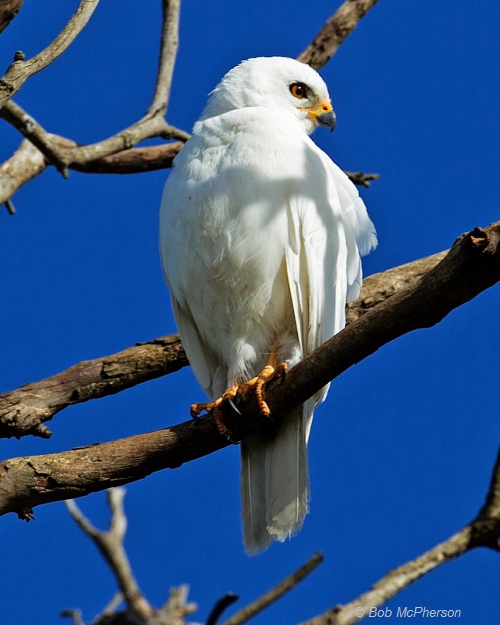
Distribution
In Victoria, the stronghold of the Grey Goshawk, particularly the white morph, is in the Otway Ranges (Otway Ranges bioregion). Grey or white individuals occur at lower densities in the Strzelecki Ranges, Gippsland Plains, Glenelg Plain and Otway Plains, however, appear to be rare or absent from more extensive forests such as in the Eastern Uplands and East Gippsland Plains (Emison et al. 1987).
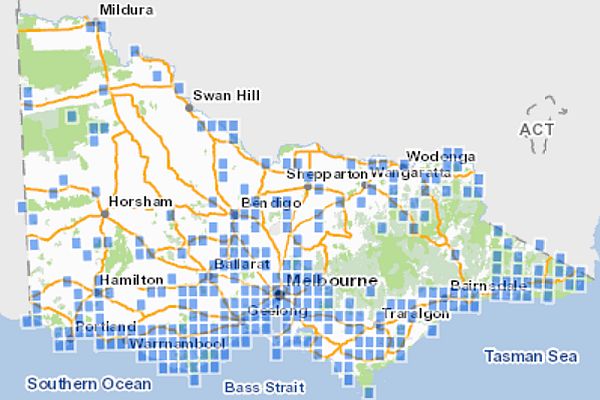
Source: Victorian Biodiversity Atlas, Department of Energy, Environment and Climate Action (DEECA) , Victoria 2024.
Ecology & Habitat
Throughout its range the Grey Goshawk generally favours tall, wet forests, particularly in gullies, for roosting and hunting. It depends on mature forests for breeding, rarely using forest regrowth less than 30 years old (Marchant & Higgins 1993). They are also seen in woodlands, dry forests, wooded farmlands and suburban parks below altitudes of 500 m.
Only females and immature birds hunt in urban and agricultural areas leading a very solitary and secretive life (Mooney & Holdsworth 1988).
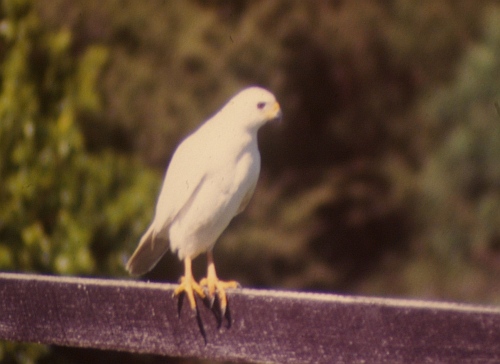
Nesting
Records from Victoria indicate that nesting takes place in the Spring months of August to November. Breeding appears to be confined to dense, wet old-growth forests at low to medium altitudes and nest sites are almost always associated with watercourses (Mooney & Holdsworth 1988). Nest sites are found in a limited range of habitats and tree types, being largely confined to wet forested areas and are likely to be selected according the availability of food. Nests are usually high in the canopy, placed in major forks next to the trunk or on horizontal branches with an easterly aspect to receive the morning sun and shelter from prevailing winds.
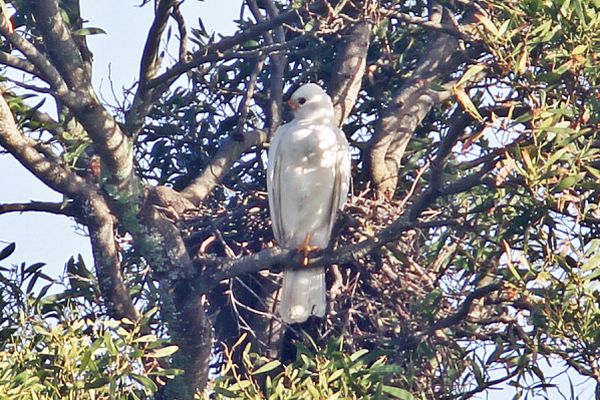
Two to four eggs, usually three, are laid in a large nest made of thin dry sticks and lined with green leaves. The same nest may be used for several years. The eggs hatch after 35 days of incubation and chicks are fledged in about 37 days. Newly fledged young stay fairly close to the nest for 2-3 weeks and in this time they are entirely dependent on their parents for food (Marchant & Higgins 1993).
No quantitative studies have been done on nest dispersion, however Mooney (1986) estimated that the breeding density in Tasmania was 2-3 pairs/100 km2. Other studies in Tasmania suggest that pairs seem to concentrate their activities in small favourable areas of approximately 10 km2 that have a variety vegetation types.
Feeding
The Grey Goshawk is an opportunistic hunter preying mostly on mammals, such as rabbits, possums and sometimes bats. They also prey on birds, reptiles and insects and hunt from either concealed or exposed perches and often take prey both in flight and on the ground.
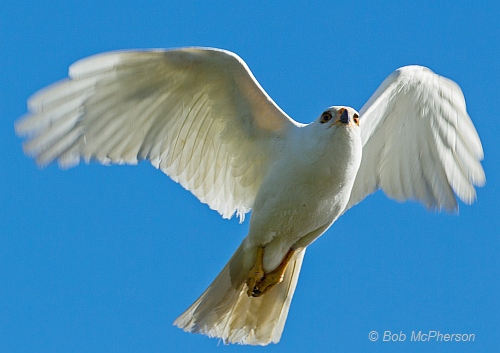
Threats
The IUCN considers the overall population to be decreasing across it range (BirdLife International. 2014).
The Grey Goshawk has not been well studied in Victoria and little is known about it outside of the Otway Ranges. Both its range and abundance within its range appear to be declining as its habitat has been extensively logged and cleared for agriculture and human inhabitancy.
Since European settlement, 65% of Victoria's forest cover has been cleared (Woodgate & Black 1988), and only 5% of freehold land remains forested. In addition, the limited availability of mature forests means that high-intensity wildfires now also represent a threat to the species’ survival (SAC 2003).
Increased human presence has been detrimental to nesting Grey Goshawks because they are sensitive to disturbance and may desert nests and young. A study in Tasmania by Mooney and Holdsworth (1988) showed that when nesting they seem to tolerate some indirect disturbance to within 100 m such as selective logging and limited road-building. However, more intense or direct disturbance such as wide clearing for agriculture, settlement or logging usually results in desertion of the nest. Although there is limited direct evidence, other possible threats which may be implicated in the decline of the species in Victoria include:
- deliberate shooting;
- direct poisoning during Dog and Fox control programs;
- secondary poisoning during Rabbit control programs;
- bioaccumulation of pollutants; and
- eggshell thinning due to the past use of DDT.
In its final recommendation the Scientific Advisory Committee (SAC 2003) has determined that the Grey Goshawk is:
- in a demonstrable state of decline which is likely to result in extinction;
- significantly prone to future threats which are likely to result in extinction; and
- very rare in terms of abundance and distribution.
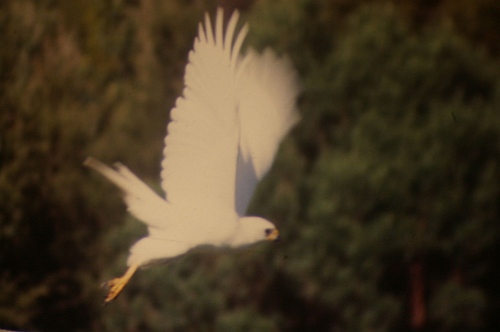
Conservation & Management
Suggested short-term objectives
- obtain an accurate estimate of the total breeding population of Grey Goshawks in Victoria within five years.
- identify and protect all known nest sites.
- identify and maintain networks of foraging habitat.
- implement management prescriptions for designated habitat areas within State forest and conservation reserves; and
- monitor population sizes to determine if management prescriptions are effective and to assess if viable populations have been achieved.
Suggested long-term objectives
- find out more about the ecology of the species both in areas where it is resident and areas where it is scarce;
- protect sufficient areas of remaining habitat to ensure that viable populations are able to survive and breed successfully in the wild;
- minimise threatening processes such as habitat destruction, overgrazing and egg collection (unless collection is authorised for approved research);
- determine the effects of habitat reduction or fragmentation on the Grey Goshawk;
- generate community awareness and promote the restoration of Grey Goshawk habitat on private land and emphasise the need to protect sites which they occupy; and
- identify appropriate fire regimes.
Suggested Research and Monitoring
To manage the Grey Goshawk effectively, it is necessary to quantify the population size (especially the breeding population size) and understand the impacts of habitat fragmentation/disturbance on breeding success and dispersal capabilities. There is little information about the extent of dispersal of the species, both within Victoria and other states. Information regarding the dispersal of the species in Victoria is required to determine whether there is sufficient genetic exchange, but there is no evidence that the Victorian populations are genetically isolated.
Detailed investigations (e.g. radio-telemetry studies) are also needed to determine densities, home ranges and dispersal accurately before long-term management prescriptions can be prepared.
Accurately establish the range of the Grey Goshawk in Victoria and adjoining states.
Increase reports of sightings of Grey Goshawks so they can be added to Victorian Biodiversity Atlas and ensure known nest sites are recorded.
Research could be undertaken by Universities, Birds Australia and research institutes (e.g. Arthur Rylah Institute) into the density of Grey Goshawk populations, impacts of current forest management practices on nest site availability, prey density, recruitment, home range requirements and dispersal capabilities in all habitat types occupied in Victoria.
Managment planning
Protect know Goshawk sites in State forest through application of Special Protection Zones (SPZ) and/or Special Management Zones (SMZ).
Locate, monitor and protect all known Grey Goshawk habitat sites within the parks and reserves system and in smaller sites endeavour to obtain co-operative management from adjoining landowners as appropriate.
Parcels of Crown land having Grey Goshawk conservation values and suitable habitat should be identified and managed to protect values.
Protect habitats on private land known to support Grey Goshawk through voluntary agreements (e.g. Trust for Nature covenants, Land for Wildlife Scheme) and local planning schemes if necessary.
Consult with landholders regarding nest sites or potential nest sites on their property to ensure the long-term protection of such sites eg. through Biodiversity Action Planning or Living Landscapes planning.
Grey Goshawk (white morph) perched but always alert. Footage: courtesy Bob McPherson.
Projects & Partnerships
The Grey Goshawk (white morph) has been selected as a focal species by the Upper Barwon community as part of the Upper Barwon Landcare Network Linking Environment and Farms project. Landholders conduct observations of Grey Goshawk with the catchment, these results will be used as a guide to measure habitat protection and enhancement success across the whole landscape.
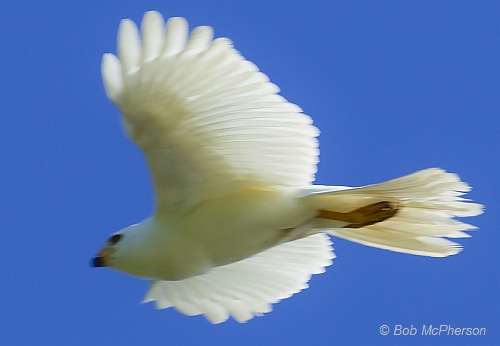
References & Links
- Baker-Gabb, D.J. (1984). Morphometric data and dimorphism indices of some Australian raptors. Corella 8(3): 61-63.
- BirdLife International. 2014. Accipiter novaehollandiae. The IUCN Red List of Threatened Species 2014: e.T22727714A40830876. http://dx.doi.org/10.2305/IUCN.UK.2014-2.RLTS.T22727714A40830876.en . Downloaded on 24 September 2015.
- Blakers, M., Davies, S.J.J.F. and Reilly, P.N. (1984). The Atlas of Australian Birds. Royal Australasian Ornithologists Union. Melbourne University Press, Melbourne.
- FFG Threatened List (2025) Flora and Fauna Guarantee Act 1988 - Threatened List - March 2025, Department of Energy, Environment and Climate Action (DEECA) , Victoria.
- Emison, W.B., Beardsell, C.M., Norman, F.I., Loyn, R. & Bennet, S.C. (1987). Atlas of Victorian Birds. Department of Conservation, Forests and Lands and RAOU, Melbourne.
- Hollands, D. (1984). Eagles, Hawks and Falcons of Australia, 2nd Ed. Bloomings Books, Melbourne.
- Marchant, S. & Higgins, P. (1993). The Handbook of Australian, New Zealand & Antarctic Birds. (Volume 2, Raptors to Lapwings). Oxford University Press, Melbourne.
- Mooney, N.J. (1986). Australasian Raptor Association News 7: 45-46.
- Mooney, N.J. (1987). Australasian Raptor Association News 8: 46-48.
- Mooney, N.J., Holdsworth, M. (1988). Observations of the use of habitat by the grey goshawk in Tasmania. Tasmanian Bird Report 17: 1-12.
- SAC (1991). Final Recommendation on a nomination for listing: The loss of hollow bearing trees from Victorian native forests as a potentially threatening process (Nomination No. 100). Scientific Advisory Committee, Flora and Fauna Guarantee. Department of Conservation and Natural Resources, Melbourne.
- SAC (2003). Final Recommendation on a nomination for listing: Grey Goshawk Accipiter novaehollandiae (Nomination No. 691). Scientific Advisory Committee, Flora and Fauna Guarantee. Department of Sustainability and Environment: Melbourne.
- Personal Communication: Richard Loyn, Arthur Rylah Institute. By A. Biasi.
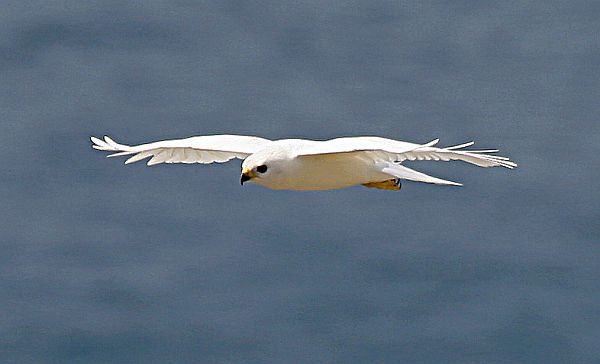
Please contribute information regarding the Grey Goshawk in Victoria - observations, images or projects. Contact SWIFFT

